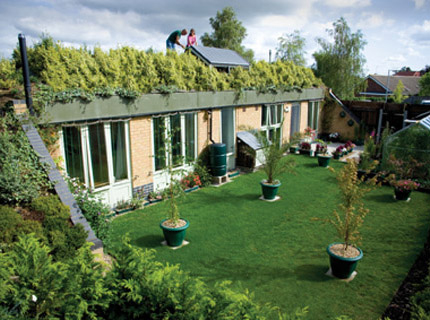earth-sheltered home orientation

A major aspect of site planning for an earth-sheltered house or other earth-sheltered building is the location and orientation of the structure. Although a house may be referred to as earth-sheltered, it shouldn't be thought of as being completely covered by earth since window and door openings are required and desirable for a number of reasons. The grouping of these openings and the direction in which they face can be referred to as the orientation of the structure on the site. The three major determinants of orientation are:
Proper orientation of an earth-sheltered house with respect to sun and wind can produce significant energy savings in addition to those inherent to earth sheltering. Exterior views are an important aesthetic and psychological determinant of orientation.
Sun
The sun is one of the most important determinants in energy efficient building design. The radiant energy from the sun can be used in both an active and a passive manner to provide heat for a structure. Most types of active solar collector systems employ a flat plate collector which may be directly attached or located adjacent to the building. The use of an active solar collector system attached to the structure will have direct impact on the orientation and design of an earth-sheltered residence. usually the collector will be facing directly south, but this may vary depending on the particular system.
All passive solar collection methods are based on trapping the radiant energy of the sun which enters the house through the windows. The use of passive solar collection techniques in an energy efficient residence is a very desirable concept since it does not involve the capital expense that an active solar collector does and can provide a substantial amount of energy. A double-glazed window facing south will produce a net energy gain even without the use of drapes or shutters at night. This available radiant heat from the sun has a great impact on site orientation of earth-sheltered design where the window openings are likely to be concentrated on one side of the house in order to maximize the earth cover.
Considering sunlight alone, the best site orientation for any earth-sheltered house would place all of the window openings on the south side with the remaining three sides completely earth covered. Passive solar collection is diminished considerably with east and west facing windows and eliminated completely on the north side. It must be recognized that other site and program constraints may prevent such a solution. In such cases, other design alternatives may be used to maximize solar heat gain. A skylight, for example, may be used to collect passive solar energy although it must be carefully designed or it may become a net energy loss. It is also important to note that while sunlight is desirable in the heating season it is not in the cooling season. Various techniques exist to reduce solar heat gain in the summer such as vegetation, overhangs, or shutters.
Wind
The effect of wind on the orientation of an earth-sheltered structure is a serious energy consideration. Since direct exposure to cold winter winds increases heat loss due to infiltration and a wind chill effect, it is desirable to protect a building as much as possible from this exposure. In the northern hemisphere the prevailing winter winds are from the northwest. Minimizing window and door openings on the north and west side of the house will enhance its energy performance. Earth sheltered construction offers a very unique opportunity to totally shield the structure from prevailing winter winds and use the earth to completely divert the wind over the structure. An earth sheltered design which includes a central courtyard may be substantially protected from prevailing winds, but minor wind turbulence may result. The behavior of this wind turbulence depends on many specific details of a design such as the size of the courtyards, the edge details, and the use of landscaping.
In the summer it is desirable to take advantage of prevailing breezes to provide natural ventilation. Generally the prevailing summer breezes are from the southeast, although this can vary from site to site depending on local conditions, trees, and topography. Unfortunately, the orientation of an earth sheltered structure with all window openings to the south will not create a well ventilated house. Some outlets such as windows or vents must be provided on the north side or the top of the house to create cross ventilation. There are many possible design variations which will result in good natural ventilation. If a designer wishes to maximize the earth cover at the expense of natural ventilation some form of mechanical ventilation can be provided.
Views
The presence of a desirable or undesirable view on a residential site is typically a major determinant of the window orientation. In designing an earth sheltered home on a site with a predominant scenic view, there are two important considerations. First, if the desirable view is not to the south, then the orientation of major window openings toward the view will result in less potential heat gain from the sun. The second consideration is the ability to clearly see an exterior view from an earth sheltered house which may be lower than a typical house. This may not be a problem on a sloping site, but on a flat site there are several design alternatives which allow a clear exterior view from an earth sheltered space.
In the case of an undesirable view such as a highway or an adjacent building, the orientation of major window openings away from the view is important. Earth sheltered designs may be particularly effective in screening out undesirable views by orienting windows into courtyards which are virtually isolated from the surrounding environment.
